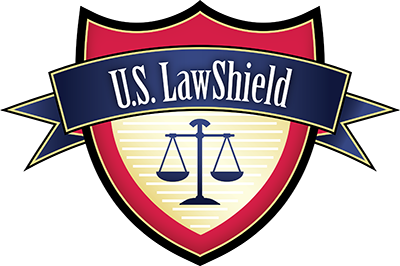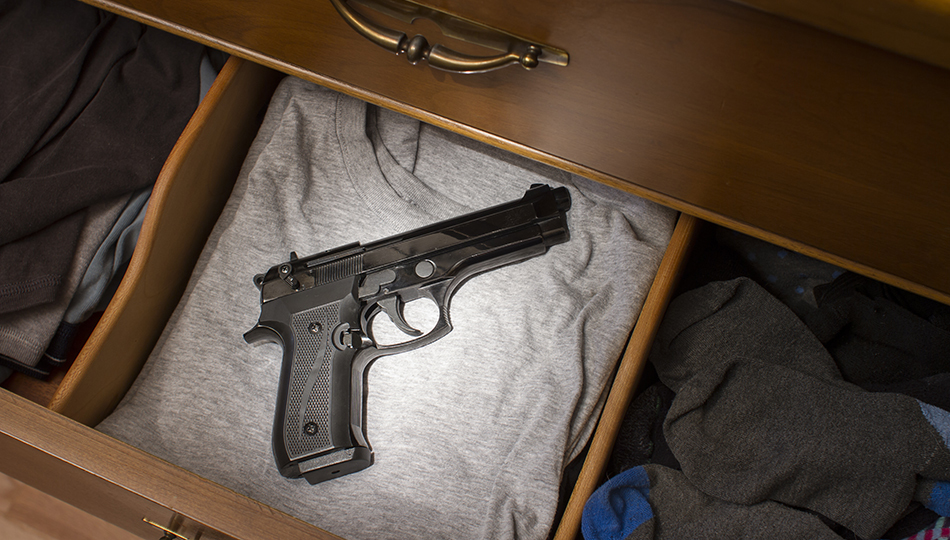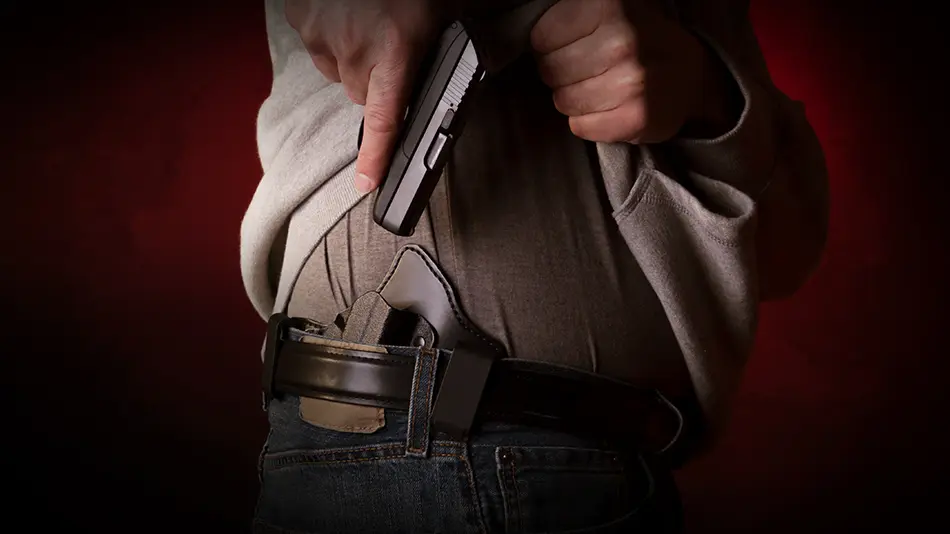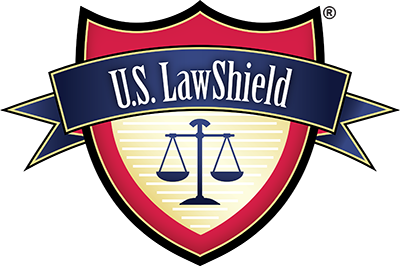What is Brandishing?
Depending on which survey you read, there are anywhere between 100,000 and 3.6 million defensive gun uses per year in the United States. One thing that almost everyone who studies such things agrees on is that, in a large number of the defensive gun uses that take place each year, no shot is ever fired. So, what separates displaying a firearm lawfully—or even justifiably pointing a firearm at another person—from a criminal charge of “brandishing,” or the unlawful display of a firearm?
If you are interested in carrying a firearm for self-defense, something you need to make yourself aware of is when it is legally justifiable to display or draw a firearm to defend yourself, and how to avoid potentially negative interactions with police officers or law enforcement that may stem from doing so. To that point, let’s look at a few things you should know.
What Does Brandishing Mean?
Merriam-Webster® defines brandish as “to shake or wave (something, such as a weapon) menacingly.” Federal law defines brandishing as:
The term “brandish” means, with respect to a firearm, to display all or part of the firearm, or otherwise make the presence of the firearm known to another person, in order to intimidate that person, regardless of whether the firearm is directly visible to that person. 18 U.S.C. § 924(c)(4).
Complicating the matter, however, is that only a few states include the actual term “brandishing” or the phrase “brandishing a weapon” in their laws. As a general rule of thumb, what people think of as “brandishing” can be defined as the intentional and unlawful display of a firearm or deadly weapon to threaten, intimidate, or coerce someone, whether or not the firearm or deadly weapon is visible to that person. Often, “brandishing” includes showing a firearm in an aggressive manner, but aggression is not always necessary to be guilty of a crime associated with “brandishing.”
To be very clear, this does not mean that displaying or drawing a firearm is an illegal act in all situations. There are scenarios where it may be prudent and legally justified to draw and display a firearm. However, the difference between unlawfully brandishing a deadly weapon and drawing and displaying a firearm during a justified instance of self-defensive may not be as clear as it appears.
For instance, brandishing a weapon may lead to charges such as the unlawful carrying of a weapon, deadly conduct, terroristic threat, disorderly conduct, menacing, or assault with a deadly weapon. If accused of a crime, you will have to deal with law enforcement, at a minimum. If convicted, these charges could result in a permanent criminal history and you risk punishment that may include months in the county jail or years in prison. On the other hand, the justified display of a firearm is just that, justified.
What Constitutes Brandishing a Firearm?
As noted, “brandishing” a firearm is the unlawful display of a firearm. Generally, the display of the firearm must be intended to intimidate, coerce, or threaten someone to be considered “brandishing.” Remember, “intent” can be established through other factors outside of your perception. This is one of the reasons you must always be very careful when carrying a firearm. You may not have thought your conduct was overtly threatening at the moment, but a jury may determine your intent differently through the examination of other external factors.
It’s important to note that, in some places, even SAYING you have a gun can result in criminal charges for what people think of as “brandishing.” For instance, if you were to get into a verbal altercation with another person and say: “I’ve got a gun on me, you better stop running your mouth,” even if the person you speak to never sees the gun, you may be ultimately found guilty of a crime relating to “brandishing” a firearm. Ultimately, if you are involved in an incident that goes to court the jury’s perception of your intent and the reasonableness of your actions will be what determines whether or not you’ve committed a crime in the eyes of the law, not your perception of the event.
If you choose to carry a gun as part of your daily routine, there are several things to keep in mind to avoid unintentionally “brandishing” a firearm. The first thing to remember is that using the firearm in any capacity—and yes, displaying your firearm can be considered “use”—during a self-defense incident or social interaction that has the potential to become a self-defense incident, is ALWAYS an option of last resort. Whenever it is possible to resolve a situation without involving the firearm it’s imperative you do so. While training and education are essential, the only time it is acceptable to use a firearm is when you have no other choice.
Enjoying this content? Find out how you can get more essential updates and self-defense information just like this sent straight to your inbox.
Is Brandishing a Weapon a Felony?
State laws differ and whether brandishing is considered a misdemeanor, a felony, or even a crime at all is going to depend on your state’s laws. It’s also important to note that, while many places do not specifically have “brandishing” laws, they may refer to the improper or intentional display of a firearm or have similar laws like assault with a deadly weapon, menacing, or disorderly conduct. While your state’s laws may not specifically refer to the term “brandishing,” statutes—or even case law or jury instructions—may describe certain behavior that many people traditionally think of as “brandishing.”
Further complicating the matter is that, depending on where you live, brandishing may be considered a wobbler offense. A wobbler is a crime that may be prosecuted as either a misdemeanor or a felony depending on prosecutorial discretion, the instructions of the judge, or both. Generally, the specific nature of the offense will be considered in determining whether to pursue the lesser or greater charge. California is one such state that treats brandishing as a wobbler offense.
Can You Brandish a Gun on Your Property?
Whether or not it is legal for you to carry a gun on your property, either openly or concealed, is going to be determined by your state’s laws. As far as the legality of displaying a firearm in a defensive situation is concerned, there are still going to be criteria and elements that need to be met to justify the use of a deadly weapon in any defensive scenario, even if you don’t end up firing a shot.
That’s not to say that there aren’t situations where you might need to draw your gun, but not fire it. Generally, if someone is attempting to cause you or another great bodily harm AND you reasonably believe you (or another) is in immediate danger of death or great bodily harm—and you did not provoke the attack (with limited exceptions), you may be justified in your use of force or deadly force. What many people misunderstand is that displaying a firearm in response to a threat from another is widely considered a use of deadly force whether it is fired or not.
So, the question becomes, “If I need to be justified in using lethal force to legally point a gun at someone else, why wouldn’t those same circumstances force me to fire the gun?” Simply put, displaying a firearm without causing the loss of life may be sufficient to stop an attack. There are many situations that will resolve themselves as soon as a gun is presented. Concerning self-defense, the primary purpose of a firearm is to STOP an attack once it’s begun. If that can be accomplished simply by drawing a firearm but not firing it, that is the preferred outcome. Unfortunately, sometimes you may have no other choice but to shoot someone in order to save your life or the life of someone else, but firing a shot should ALWAYS be an option of last resort.
Is Open Carry Brandishing?
Where legally permitted, open carry is not in and of itself considered “brandishing,” so long as the person who is open carrying does so in accordance with local, state, and federal laws. Many states have laws that specifically address lawful methods of carry, and these laws may even place limitations on what types of firearms are allowed to be carried openly.
If we look at “brandishing” laws or laws pertaining to the illegal display of a firearm, and how those laws are written across the nation, the lawful use of a firearm will be determined based on what the person with the firearm was doing at the time of its alleged use. For instance, if the open carrying of a firearm is legal, and someone who is open carrying is just going about their normal day, they would likely not be charged with a crime relating to “brandishing” a firearm.
However, as soon as a person open carrying a firearm attempts to intimidate someone else, or acts aggressively towards another person while drawing attention to the gun they are carrying, or threatens someone else directly with their visible firearm, the situation has drastically changed. These are just a few of the potential actions that can lead to intervention by law enforcement, potentially resulting in a quick charge or arrest, and possible legal trouble later on.
So, What Does it All Mean?
“Brandishing” can be a difficult thing for many to understand, especially since the law differs almost everywhere you go. Always remember that you can be charged with a crime even if you are not seemingly acting in an angry or threatening manner. However, if you make sure that you always use firearms as a last resort when there are no other available options—and only at the level of force the law allows—and familiarize yourself with your state’s use of force laws, you’ll be less likely to ever be charged with “brandishing.” If you want to see what laws your state has regarding “brandishing” offenses, your best option will always be to consult your U.S. LawShield attorney so they can help explain what all of this actually means for you.
Your Protection Starts Here!
There’s nothing more important than protecting yourself and your family. By joining our community of members, you can count on our self-defense coverage, with meaningful options and benefits that make a real difference.
The information provided in this publication is intended to provide general information to individuals and is not legal advice. The information included in this publication may not be quoted or referred to in any other publication without the prior written consent of U.S. LawShield, to be given or withheld at our discretion. The information is not a substitute for, and does not replace the advice or representation of a licensed attorney. We strive to ensure the information included in this publication is accurate and current, however, no claim is made to the accuracy of the information and we are not responsible for any consequences that may result from the use of information in this publication. The use of this publication does not create an attorney-client relationship between U.S. LawShield, any independent program attorney, and any individual.





If you draw a pistol and don’t shoot anyone, it’s brandishing, depending on where you are, how many gun charges the prosecutor’s office needs this year, the political situation, such as if your Dad was on the DA’s opponent’s campaign.
Al Grayson, that statement as a blanket statement is not true. With no context it goes several different directions all at the same time. That’s why Law Shield exists.
As. Police officer and homicide detective for many years I was guilty of “brandishing “
a firearm almost weekly if not daily. I have seen a dramatic change in dirdbags when a firearm is pointed at them. As well , I have interviewed many homeowners who were save by showing a firearm. The real problem arises when a shoplifter turns into an aggravated assault/robbery actor. My advice after all these years is if a life is endangered, use your firearm, if not don’t take the risk.
JWR, police officers have a different standard than civilians. We employ officers to go in search of criminal activity and therefore permit them to reasonably display a firearm or less-lethal weapon when uncertain circumstances present. However, when it is clear a firearm is not reasonable, the officer must stop displaying it. The standard is generally much higher for civilians. As the article stated. There must be a reasonable perception that the actor’s behavior is likely to lead to imminent death or serious bodily injury. It is vital for the civilian to be clearly justified when displaying a firearm in circumstances that were clearly threatening death or serious injury. Many jurisdictions are not charging misdemeanor brandishing anymore. They are charging defenders with Assault with a Deadly Weapon, a Class A felony, usually worth 20 years to life plus a firearm enhancement (because the “victim” said they feared they were going to be killed when the firearm was brandished). Brandishing should be a last-ditch effort to avoid a shooting. The operative concept is LAST-DITCH just before shooting.
It is a shame that the line between legal and illegal has gotten to the point it has.
I’m confused now. Please also explain displaying a firearm to “create apprehension” Which is supposed to be legal.
One of the best sayings I have heard:
Always remeber there is a difference between right and wrong and legal and illegal”
As someone who HAS needed to brandish a firearm to stop a threat without the need to even point it at the person, I have already had to deal with Law Enforcement on this issue. The individual pressed charges on me for doing so, the DA in my local city looked into it and found I WAS JUSTIFIED in displaying my firearm in the manner I did. The biggest issue I have seen is brandishing during a road rage incident (mine wasn’t connected to road rage), the other driver will call the police and they will tell them you threatened THEM. Get a dashcam. The only advice I can give for those situations. It has saved more then one person from jail.
From the limited studies I’ve seen, “brandishing” in a self-defense situation is far more likely than actually having to shoot. Criminals in general are looking for weak/helpless targets, and suddenly facing an armed “victim” is the last thing they are looking for. In my only first-hand experience, just drawing my handgun caused what I believed to be two guys trying to snatch my wife off the street to drive off empty handed.
If you have to draw your weapon in a self defense situation, fire or not, ALWAYS be the first to call 9-1-1.
Not disagreeing with what you say; but this broad definition could deter “brandishing” that would save a perp’s life. Most criminals would prefer not to go up against someone who is armed (unless they have to). Indicating or demonstrating that you’re packing could inspire them to go pick on someone else.
How do you feel about “Sneaky Pete” style sleeve holsters, and would you consider simply wearing one an act of brandishing?
A mobile home repo company came onto my property to repo a mobile home belonging to someone else. I was not there, and they dragged my vehicle 75 ft in order to get through. No tow truck was called, and I was not asked permission to move my own vehicle. When I walked down with my 12 gauge (never waving it around, not pointing it. Simply carrying it) to go down and speak with someone about why my vehicle had been dragged without my permission, the repo people called law enforcement. They came out and put my in handcuffs and told me that I was brandishing a firearm and was going to jail for it. The deputies got a call from something else going on and decided to let me go. I have audio of almost the entire event. I have never been arrested and have no prior history. Is there anything I can do legally?
This is a great question. If you’re a member, please call our non-emergency line to get an answer from an independent program attorney at 877-448-6839.
Great I have read your article and enjoyed it a lot and am excited to read more from you.
If someone says they’ll kill you and they have a gun in they’re in a vehicle then attempt to swerve at there vehicle into yours and I feel threatened at that point we should have the right to pull a firearm to STOP the threat. Yes or no?
If someone said that you brandish a gun and they called the police , but the police didn’t find any gun nowhere on the person they called the police o . should they Lock that person up for anything
I really hope Florida law isn’t that screwed up. If it is it should be changed to make it clear what is and isn’t with our crossing our US constitution because it trumps Florida law.
Texas Penal Code 9.04: The threat of force is justified when the use of force is justified by this chapter. For purposes of this section, a threat to cause death or serious bodily injury by the production of a weapon or otherwise, as long as the actor’s purpose is limited to creating an apprehension that he will use deadly force if necessary, does not constitute the use of deadly force.
I came home with wife after long day out of town, and our front door to the house was wide open. I left auto running in driveway and instructed wife to drive away quickly and call 9-1-1 if shooting started. That’s when I drew my legal concealed weapon and entered the house to determine if anyone was wrongfully inside.
The house was clear of danger, the door determined to have blown open when not properly secured earlier. If i had found a stranger inside, might I have been justified to hold him/her at gun point because of stranger’s obvious bad intent?
Maybe too many circumstantial questions with this scenario?